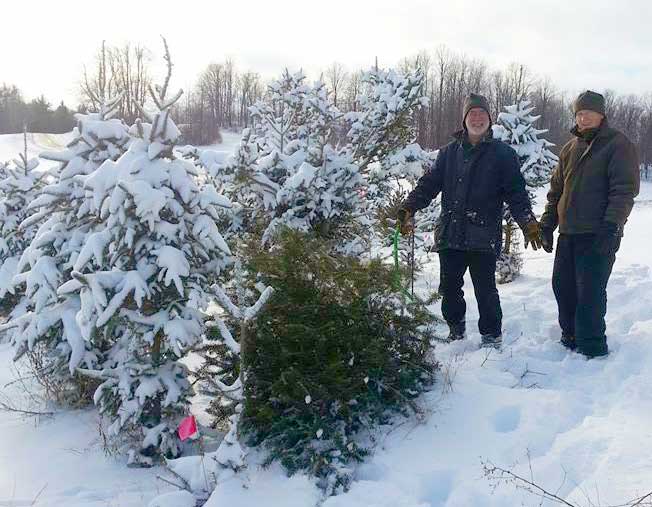Pining for that real evergreen smell

Radio Bob and Guy Berard are two of the 11 million Americans who bring home real Christmas trees. Photo: Jackie Sauter
Of all the memorable aromas of the holiday season, nothing evokes its spirit quite like the smell of fresh-cut evergreen. Although over 80% of American households where Christmas is observed use artificial trees, about eleven million families still bring home a real tree.
Every species of conifer has its own mixture of sweet-smelling terpenols and esters that account for that “piney woods” perfume. While all natural Christmas trees share many of the same aromatic compounds, some people prefer the smell of a certain type of tree, possibly one they remember from childhood. No chemistry lab can make a polyvinylchloride tree smell like fresh pine, fir or spruce. A natural Christmas tree is, among other things, a giant holiday potpourri.
The origins of the Christmas tree are unclear, but according to the Encyclopedia Britannica, “The use of evergreen trees, wreaths, and garlands to symbolize eternal life was a custom of the ancient Egyptians, Chinese, and Hebrews. Tree worship was common among the pagan Europeans and survived their conversion to Christianity in the Scandinavian customs of decorating the house and barn with evergreens at the New Year to scare away the devil and of setting up a tree for the birds during Christmas.”
In Eastern Europe in the fifteenth century, decorated Christmas trees were set up inside guild halls. Then in sixteenth-century Germany, Martin Luther apparently helped kindle (so to speak) the custom of the indoor home Christmas tree by bringing an evergreen tree into his house and decorating it with candles. For centuries, Christmas trees were brought into homes on December 24th and were not removed until after the Christian feast of Epiphany on January 6th.
In terms of New York State favorites, the firs—Douglas, balsam, and Fraser—are very popular, being very aromatic evergreens. Grand and Concolor fir smell great too. When kept in water, firs all have excellent needle retention.
Scots and white pine also keep their needles well. While our native white pine is more fragrant than Scots, the latter far outsells the former, possibly because the sturdy Scots can bear quite a load of decorations without its branches drooping.
Not only do spruces have strong branches, they have a strongly pyramidal shape. None of the spruces is as fragrant as firs or pines, though. Many field guides indicate white spruce buds smell like cat urine, but based on robust white spruce sales, plenty of folks don’t think so.
Do yourself (and the local economy) a favor by purchasing your natural tree from a local vendor, who can help you select the best kind of tree for your preferences, and also let you know how fresh they are. Some trees at large retail outlets were cut several weeks before they show up at stores. Of course, cutting your own tree from a Christmas tree grower ensures freshness and can be a memorable family experience. Usually it’s a positive one.
For the most fragrance and the least mess (and fire hazard), cut a one- to two-inch “cookie” off the trunk before placing it in water, and top off the reservoir every two days. Research indicates products that claim to improve needle retention don’t work, so save your money. You’ll also save with LED tree lights which use much less power than conventional ones. Plus, they don’t dry out the tree as much. Fire-safety experts say you should keep trees away from heat sources, including electronics, and turn off tree lights when you leave the room, even if only for a minute.
Whatever your traditions, may your family, friends, and evergreens all be well-hydrated, sweet-scented and a source of good cheer this holiday season.
Paul Hetzler is Horticulture & Natural Resources Educator for Cornell Cooperative Extension of St. Lawrence County
Tags: holidays, horticulture








I see that Jackie Sauter is doing all the hard work — taking a picture